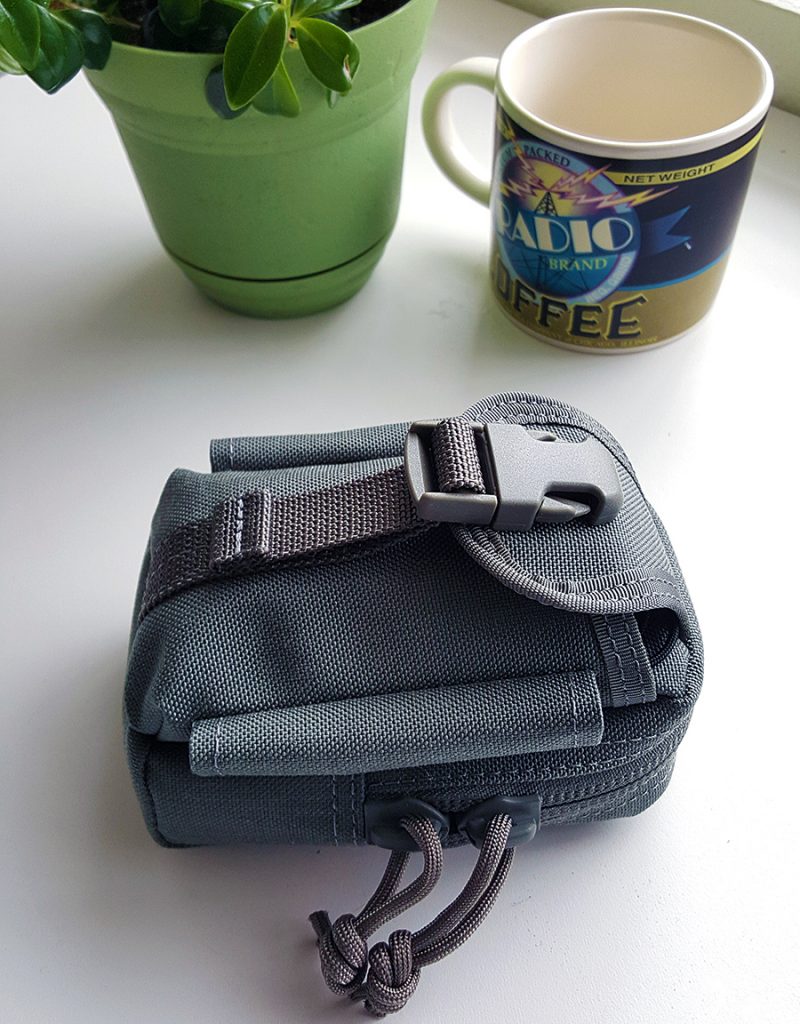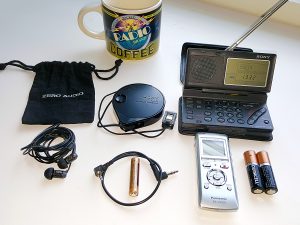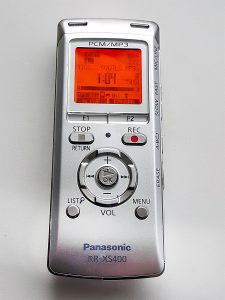 In a 2014 article, this site’s administrator Thomas Witherspoon introduced readers to the CIA’s Survival Kit which is housed in a superbly sturdy waistpack, the Maxpedition M-2. Thomas observed that the M-2 pouch is perfectly suited to holding the diminutive Sony ICF-SW100 receiver.
In a 2014 article, this site’s administrator Thomas Witherspoon introduced readers to the CIA’s Survival Kit which is housed in a superbly sturdy waistpack, the Maxpedition M-2. Thomas observed that the M-2 pouch is perfectly suited to holding the diminutive Sony ICF-SW100 receiver.
I was intrigued by that possibility, but only recently tried to combine the two after I resurrected another ICF-SW100 that fell silent to the chronic broken ribbon cable problem. Indeed, the radio is a perfect fit and the M-2 is impressively solid and well designed. I was not aware of the Maxpedition firm prior to learning of the M-2 bag, but I see in various forums they are a major player in well-made gear for the survivalist and outdoor enthusiast crowds. The M-2 is a very popular item, and one or more of the four available colors are sometimes out of stock at the manufacturer. Fortunately there are many sellers on Amazon and Ebay who have these waistpacks available.
What is EDC you may ask? It refers to “Every Day Carry”, the essentials that an individual deems necessary for their lifestyle or a particular activity. For me, an EDC bag is taken along on hikes or other outings to the countryside and typically contains a compact shortwave radio and related accessories. It’s always fun to stop for lunch or a break in a remote location and be able to search for interesting stations whenever the mood strikes.
This photo shows what I’m able to carry in the Maxpedition M-2 bag; a coffee mug is shown for size comparison. Contents of the “kit” include: 
- The Sony ICF-SW100 receiver
- Zero Audio Carbo Tenore In-Ear Monitors & soft pouch
- Sony AN-71 reel-up antenna
- Panasonic RR-XS400 Digital Voice Recorder
- Short 3.5mm male-to-male stereo audio patch cable
- Two extra AA batteries for the Sony receiver
- An extra AAA battery for the Panasonic Digital Voice Recorder
A few comments on the contents. The Zero Audio Carbo Tenore In-Ear Monitors (IEMs) provide excellent audio quality for their price. They are among a handful of IEMs regularly recommended by budget-minded audiophiles on the popular Head-fi.org site. I like these IEMs not only for the audio quality, but also their small size (in the cloth bag) which barely fits into the M-2’s main compartment along with the ICF-SW100. Larger earbuds or IEMs might not fit the M-2 without being mangled by the hefty YKK zippers. One caution: the similar Carbo Basso model by Zero Audio is deemed by many to be overly heavy on the bass frequencies. I find the Carbo Tenore to be more than sufficient for bass heavy genres like Electronica.
The Panasonic RR-XS400 digital voice recorder has been out of production a few years, but is  a highly capable and compact recorder. It contains a hidden USB plug for charging and data transfer, has a fully featured and backlit LCD display, built-in stereo microphones, switchable LINE/MIC inputs, and other useful features. In excellent used condition the RR-XS400 is worth about $50 USD in 2017, despite some Amazon sellers trying to move them at the original $280 price.
a highly capable and compact recorder. It contains a hidden USB plug for charging and data transfer, has a fully featured and backlit LCD display, built-in stereo microphones, switchable LINE/MIC inputs, and other useful features. In excellent used condition the RR-XS400 is worth about $50 USD in 2017, despite some Amazon sellers trying to move them at the original $280 price.
The extra AAA battery for the recorder slips into the front pouch of the M-2 bag along with the Sony AN-71 antenna. The additional AA batteries for the radio, however, are held in the two “pen loops” on the left and right of the M-2. Despite these loops being open-bottomed tubes, the fit is tight enough to hold the batteries securely.
Like every portion of the Maxpedition M-2 bag, the belt loop is proportioned perfectly and sewn with precision. With the Sony ICF-SW100 EDC “kit” secured to my belt on a hike, I’m assured of quick access to a DXing opportunity, such as when hiking the Naches Loop Trail near beautiful Mt. Rainier:
Guy Atkins is a Sr. Graphic Designer for T-Mobile and lives near Seattle, Washington. He’s a regular contributor to the SWLing Post.


If you are going to take the ICF-SW100 out and about I would highly recommend doing the modification to the battery compartment spring. From the factory the ICF-SW100’s battery spring places too much pressure on the very delicate battery door. The area around the battery door is made of thin plastic and is fragile, too. The modification consists of clipping a section of the spring off and then reforming the end into a spiral so as to not damage the battery as it rests upon it.
Remove a small section at a time and then reinsert the batteries and note the reduction in effort to close the battery door. Do this until you feel that a comfortable level of effort has been reached. This will help significantly relieve stress against the two aforementioned areas. Another idea might be to not take the radio out of its case until you are wherever you wish to be to listen. Even with the spring modification dropping the radio on the corner where the battery door is will more than likely crack the plastic around that area.
It’s quite an impressive radio. It just needs a bit of care in handling.
Hi Mike, you are spot-on with that comment! The battery spring modification is something I did to this ICF-SW100 when I replaced the ribbon cable. I find that around 1-3/4 to 2 turns of the spring is satisfactory for removal.
I also updated the LCD backlighting to bright white LEDs, which makes a tremendous improvement in readability at night. (LEDs have come a long way since the 1990s! The ICF-2010/2001D model realizes an even greater benefit from new LEDs.) One other upgrade was replacing the stock speaker with a new model from the US supplier Digi-Key. It’s supposed to offer a higher quality sound.
The ICF-SW100 is certainly a receiver worthy of preservation!
Brilliant EDC pack, Guy! I love Maxpedition gear. You truly get a lot of quality for the price, in my opinion. I use a Maxpedition EDC pack as well–the Maxpedition Fatty Pocket Organizer. In fact, it’s ironic you’ve posted an article about EDC because, at the prompting of a reader, I also deconstructed my pack recently and took photos of the contents. I’ll put that post together soon!
And the Zero Audio Carbo Tenores? I was not familiar with them–I’ll grab a pair! $42 is a bargain for audiophile-grade IEMs: http://amzn.to/2mhRhMI
I think this post just cost me $65–!
-Thomas
Hi Thomas,
As they say frequently over on the Head-Fi.org site, “sorry about your wallet!”.
Some reviewers claim the Carbo Tenores are fragile, but I’ve had no issues with normal, careful handling in a year of use of these IEMs. Their replacement price is modest, in case something happens to them when I’m out and about. I would rather not risk damaging my higher quality JVC HA-FX850 IEMs, which are my mainstays at home and the office.
Thanks, Guy, for your reviews, which are indeed always helpful for the DXer.
Yes, recorders. I now have in my technical museum a fine tape recorder from Marantz as well as a portable DAT (who remembers Digital Audio Tape?) recorder and several portable MD recorders from Sony. The DAT and MD maschines provided a real time display (timestamp) during replay, which was very useful for identifying good program details for a reception report.
Currently I am using a small MP3 recorder Philips DVT6000 for portable use. After installing a firmware update it really serves me well. It also has a built-in FM radio and a switchable LINE/MIC input.
Your mention of DAT recorders brings back memories, too, Harald. I recall that they were highly sought after by live concert “tapers” in the late 80s/early 90s.
The running time stamping of MD and DAT recordings is a feature that finally pulled me away from the PMD- Marantz recorders as a DXing aid. I know a number of other DXers marveled at that “high tech” feature, too! Now in the era of SDR receivers we take the time component for granted. It is just one small component of the wealth of information found in the recorded WAV I/Q files.
Thanks for your kind comments, Walt!
I’ve used an older Tascam recorder before; the DR-1 model. It had a scroll wheel control which i found very handy. The newer versions like your DR-07 Mk 1 are excellent.
Do you remember when we thought the Marantz PMD series of cassette recorders was the pinnacle of audio recording for DXers? Then MiniDisc came along and we thought THAT format was the best! :^)
I sure do remember those days. I do believe that Colin Newell still has and uses his Marantz. I’m pleased that I held onto my high end Sony MD recorder and cassette recorders, if only to help in digitizing them into an easy MP3 format. I’m impressed with the Tascam, by the way. Purchased locally for about USD $60. I’m finding fewer and fewer bargains on eBay, my previous go to web store.
Guy has always steered me in the right direction with his thoughtful equipment reviews, all the way back to the AOR 7030 receiver. I know that purchasing anything Guy has recommended has never been anything but the right choice. Thanks for the many years of thorough reviews! There just might be a place in my DX shack for the EDS along with the Sony portable and Panasonic recorder (although I just purchased a Tascam DR-07 Mk I for this purpose!).